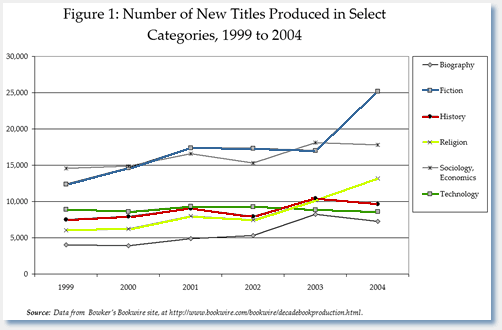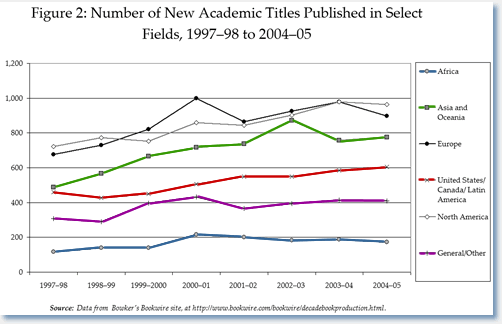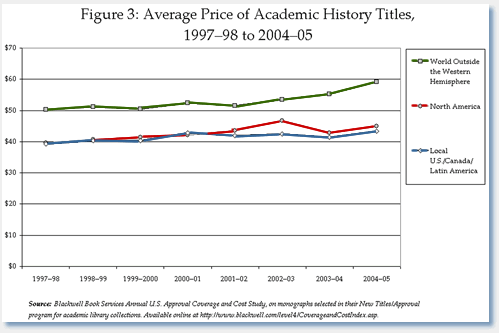News
Slight Decline in History Book Publishing, but Still Near Record Highs
The number of history books published in North America dipped slightly in 2004, but still remains near record highs. The data has to be read with caution as it contains a number of evident flaws and ambiguities. Not all history books are equal, after all, in the eyes of the history profession. Nevertheless, the vital importance of books and monographs to the health of the discipline and profession of history makes even an impressionistic picture of the state of the industry helpful. Perhaps most heartening is evidence that history titles led a surge in new books from university presses in 2004 (even though more recent estimates suggest a slight lag)
According to data published by R. R. Bowker LLC, the company that publishes the annual guide Books in Print, the number of new history titles published fell 7.4 percent—from 10,439 to 9,662 books—from 2003 to 2004.1 Despite the decline, this is still the second highest number of history books produced, almost 50 percent higher than the number of titles produced in 1993 (the first year with comparable data).
In comparison, the total number of books grew by 10.1 percent from 2003 to 2004, up to 181,199 titles in all fields. Much of the growth occurred in various types of fiction and juvenilia. Among the humanities and social sciences, philosophy and religion experienced the highest levels of growth. New books on the subject of religion, which increased almost 30 percent from the year before, surpassed publications in history for the first time in more than a decade (Figure 1).

The news from university presses, however, was much better for our discipline. Bowker singles out the history field as one of the "engines of growth" for academic publishers, after a worrying decline in new book production the year before. The number of new history books published by university presses rose 19 percent—from 1,390 titles to 1,654 in 2004—leading a 6.3 percent increase in all subject fields.
The importance of university presses as an outlet for academic works of history can hardly be understated. In 2004, 17.1 percent of the new titles in history were published by academic presses, according to Bowker. Literature was the only subject field in which a larger proportion of new works was published by academic presses.
The share of history books published by university presses has declined modestly from 1993, when university presses accounted for 18.3 percent of the new history titles. But this seems to be largely the result of growth of new titles published by trade presses, as the actual number of new history books published by academic presses grew by more than a third over that span.
Conversely, history titles are a vital part of the lists of most university presses. According to Bowker, history books comprised 11.4 percent of the new books published by university presses in 2004—second only to the rather odd category of "sociology and economics" in its tabulations.
This is markedly different from the history discipline’s position at the major trade publishers, where only 2.8 percent of the new titles they published in 2004 were in history (27.6 percent were for juveniles, and 21.2 percent were fiction books).
Geographic Differences in Publishing
The Bowker data does not allow us to assess the more specialized publications that history professionals produce, or allow us to mark out some of the differences in specific subfields of history. To assess those kinds of questions, we can draw on some useful (though flawed) information from Blackwell’s Book Services—a company that recommends lists of new "academic books" for college and university libraries.2 Since it reports its information on the academic calendar, the Blackwell’s data is also a bit more current because it covers new titles recommended in the 2004–05 academic year.
As in the Bowker data, there was a small decline in the number of history titles tabulated by Blackwell—a drop of 2 percent from the year before, to a total of 3,824 books. However, this was half the decline among all academic titles, which fell 4.3 percent to 38,448 books.
Not surprisingly, given the academic focus of their lists, university press titles comprised a much larger portion of the history books on Blackwell’s lists. They accounted for 41.8 percent of the history titles on the list, as compared to just 17.1 percent of the books in all subjects on their list—further underscoring the importance of university presses as publishers of history monographs.
Blackwell’s data is also useful for providing some indication of the portion of history books being published in different geographic fields. It categorizes the books using the Library of Congress’s cataloging system, which is hardly perfect—as anyone who has looked for books on a particular subject in a college library can attest—but still provides a systematic and stable standard.
It will come as no surprise that books on the history of North America (books cataloged with call numbers starting with the letter "E" in most college and university libraries) formed the largest segment of new academic history books. They comprised a quarter of the history titles selected—963 in all (Figure 2).

Histories of Europe comprised the next largest segment, with 893 books on the list, while histories of Asia and Oceania accounted for another 776 of the books published. The anomaly in the data is in books cataloged with call numbers starting with F—designated on the figure as "United States/Canada/Latin America." This includes both very specific local and regional histories of the U.S. and Canada as well as books on Latin America. This category had 604 titles (15.8 percent of the list).
When the data is narrowed down to just the books published by university presses, the portion of titles in the "United States/Canada/Latin America" category becomes much more prominent—comprising a quarter of the titles published. This suggests that university presses are particularly important as publishers of local histories and Latin American history. Much of the difference between Blackwell’s broad list of all history titles and the narrower list of publications of university presses was reflected in European history titles, which comprised 23.5 percent of all academic history titles on the Blackwell list, but just 16.9 percent of the books published by university presses.
The Value of History
The other useful piece of information in the Blackwell data is on the prices of academic history books. The least expensive new works in the 2004–05 academic year were on the history of the Oceania region (38 in all), which averaged $41.88 per book. This was followed by histories in the United States/Canada/Latin America category, which averaged $43.36, and books on North America’s past, which cost an average of $45.03 (Figure 3). Despite the low cost for the books on Oceania, books on regions outside of the Western Hemisphere were significantly more expensive, averaging $59.02 per book.

Notably, the averages price for histories of Europe and the Western Hemisphere at university presses were in line with the average from all publishers. One wild card in the mix is a small but significant number of titles from foreign publishers. Because of the way the data is reported, we cannot determine how much they might skew the average prices at nonacademic presses.
The average price of history books was up a bit over 5 percent, both in the broad list of academic history titles and the narrower list of titles from university presses. Looking back a bit further, the prices of books on the Western Hemisphere have shown the least amount of growth over the past five years, increasing around 8 percent during that span. Aside from a few anomalous categories with very small numbers of new books, the prices of books dealing with the histories of most of the other regions of the world have gone up by about one-third over the past five years.
All these numbers give some cause for optimism about academic publishing in history—even if that optimism has to be tempered by a more realistic assessment of the long-term health of the industry, especially when we look at specific fields in which fewer books are published each year.
—Robert B. Townsend is AHA assistant director for research and publications.
Notes
1. Data available at Bowker’s Bookwire site, at http://www.bookwire.com/bookwire/.
2. Blackwell Book Services Annual U.S. Approval Coverage and Cost Study available online at http://www.blackwell.com/level4/CoverageandCostIndex.asp.
Tags: Publishing Your Work
Comment
Please read our commenting and letters policy before submitting.






